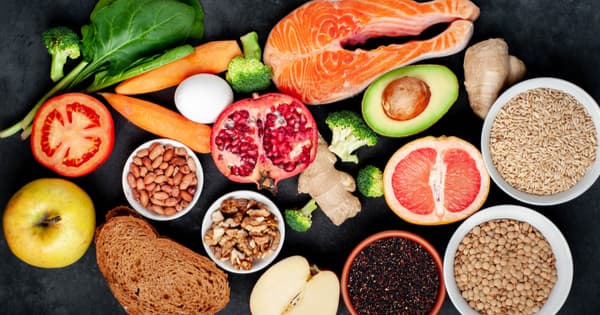Better Food Choices for Better Paddling Performance
Believe it or not, for the first time in my paddling life, last week I removed the kayaks from their garage rack, loaded them on the car's rack and drove to my favorite local launching spot as if it was a warm summer day... I mean, usually, in mid-January the Saint-Lawrence River that runs in front of my house is a frozen mass and kayakers are replaced by anglers on the ice for 5 long months. As scary as these climatic changes may appear, I decided to make the best of it by exchanging my ski poles for a carbon paddle in order to avoid getting depressed by the lack of durable snowfalls that suddenly hit my region.
Of course, it took a bit of work to convince my better half to embrace the perspective of a winter paddling adventure and to take the wet suit, long booties and pfd's out of the wardrobe where they have been carefully packed since November. "What if we get our feet wet, slip in the frigid water while launching or, worse, capsize", argued sweet hubby, sensibly. I replied diplomatically that we'd stick to the shore, wouldn't paddle in more than 3 feet of water and carefully avoid currents. So probably because he has had enough of the gym treadmill as much as I have, we finally went paddling under a superb winter sun, with the temperature hovering at a toasty 32°F keeping us nice and comfy.
But as lovely as the experience was, I quickly understood what a terrible impact six weeks of over-indulgence on Holiday treats had on our performances and level of pleasure. All of a sudden, those meat pies, pastry puffs, exquisite cookies from our friend Joanne, decadent duck rillettes and glasses of merlot came back to haunt us. After just 15 minutes of steady effort I confess I felt bloated, had headaches and stomach cramps. My partner had similar problems, complaining of a discomfort similar to "the morning after"... Once again I realized what a deep influence food intake has on well-being in general and sport performance, and I decided to do something about it right away.
Back home, I wrote down simple guidelines that could be helpful to me, my husband, and hopefully, anyone who wants to get back on track with healthy eating habits after the binge of December and the post-binge depression of January. Here it is, based upon the USDA Food pyramid, and the work of Barbara Rolls, PhD in nutrition and respected author of the Volumetrics eating and weight-control plan.
To be useful any health-oriented meal plan needs to meet three goals:
- Include a wide selection of unprocessed quality food from the five major groups (fruits and vegetables, grains, proteins, dairy, good unsaturated fats) in sufficient quantity to provide enough energy throughout the day;
- Offer foods that are easily accessible, fun to prepare and delicious and avoid at all costs feelings of deprivation or famine, because it's the quickest track toward failure.
- Put a bit of CCP in the project: commitment, creativity and planning and be determined to improve one's quality of life toward sound food choices.

Now the plan itself
1- Change some habits with no pain
First, I looked at my eating patterns since mid-December to decide what I could change easily: put less butter on my bread, in risotto, on vegetables and restrict cheese because it's rich in saturated fats. Second, limit my wine consumption to one or two glasses 2 to 3 times a week; third, keep portions of certain highly caloric foods in check while making sure to eat fruits and vegetables with every meal. Finally, I also made a priority to consume 6 to 7 portions of whole grains daily (cereals, bread, pasta, rice) instead of eating white French baguette. Whole wheat pasta is also a better option than its white counterpart because it's more flavorful and loaded with filling fibers. Finally, taking my lunch to work instead of eating out would be a clever way to save on calories, money and to guarantee quality.
2- Get the whole picture of what you should eat daily
The best way to incorporate this meal plan easily in your daily life is to know what your body needs according to your gender, age and level of activity. The USDA Food pyramid will tell you what your numbers should be. For an active woman my age, for instance, it would translate into 6 to 7 daily portions of cereals (ideally whole grains), 4 fruits, at least 5 vegetables, 5 to 6 oz of lean proteins, 3 portions of dairy products, 6 to 7 teaspoons of good unsaturated fats and 265 discretionary calories (alcohol, sweets, etc.). That's an optimal, nutritious basic food structure to work with. It also makes me realize how much and what type of food I need to stay strong and healthy and to perform well in my favorite sport. Of course, the more active you are, the more you should eat. Remember those 400-800 calories you burn each hour when you paddle?
3- It's all about sound food choices
You'd be surprised at the quantity of meals and snacks such a prescription translates into. According to the USDA Food pyramid, an active female between 31 and 50 should eat as many as 2200 calories a day to sustain her caloric needs whereas active males should add 600 calories to this rule of thumb. This means a lot of food, as long as you pick the right food. You could easily absorb all your daily calories in one stop at a fast food restaurant: just choose a double cheeseburger with bacon, large fries and mayo, top this with a jumbo piece of chocolate cake à la mode and a large soda and you'd almost be there.
On the other hand, with the same caloric budget of 2200 calories and a more healthful and carefully planned menu, you would easily go through your day without feeling deprived or hungry. Again, a woman my age could start the day with a large bowl of whole grain cereals with plain non-fat or soy milk and a banana, add a mid-morning latte with an orange, lunch on vegetable soup, a grilled chicken sandwich with salsa, avocado slices, tomatoes and non-fat sour cream and a frozen yogourt for dessert. Around 4 she'd treat herself with fresh grapes, baby carrots, a granola bar and a cup of tea before hitting the gym at 5:30 and would be back home at 7:30 only to find herself sitting in front of a homemade Cesar salad, a spaghetti with meat sauce and one or two glasses of wine. Not bad, isn't it? This is the foundation of what researcher Barbara Rolls calls the volumetrics eating plan: eat more and feel fuller on fewer calories. You can't go wrong when following the principles of the USDA Food pyramid. The whole idea is easy enough to catch: cut back on fat, load up on fruits, vegetables and grains and you will end up eating bigger portions, feeling more satisfied while absorbing fewer calories and exceeding your daily needs for disease-fighting nutrients.
4- From that pattern, play with food to create appealing menus
The last step is to have fun creating interesting meals based on those food groups and portion sizes. A meal planner and a grocery list are the easiest way to make sure you will add variety and novelty to your regimen. Go online or consult some magazines (Cooking Light and Eating Well are my favorites) for delicious, low fat and highly nutritious recipes. Be adventurous and pick new fruits and vegetables. Try new spices like saffron, dill, cilantro, curcuma. Choose lean cuts of meat, and fish loaded with Omega-3 fatty acids like mackerel or salmon. Experiment with heart-healthy unsaturated fats like olives, avocado, nuts, canola or olive oil. Let the global cuisine inspire you with its exotic fragrances. Finally, keep things simple: you don't need a five-course meal to eat well.... À votre santé! See you on the water...
Related Articles
Gliding through glass on a crisp, winter morning can be an experience like no other. Whether we’re…
If there are times that you can't kayak as much as you would like due to an injury or because the…
This Point Of View account shows the importance of choosing the right clothing when paddling. No matter…
Here we are again: The Holiday season is knocking at the door. If you are looking for simple and…



